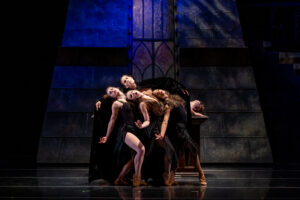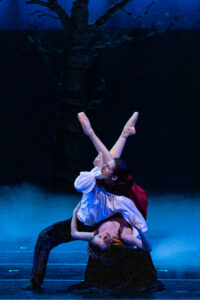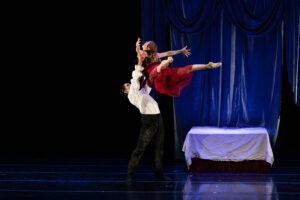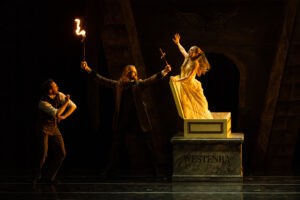



When David Nixon created his 1999 ballet Dracula—a fan favorite BalletMet recently performed for the first time in seven years—the very first scene he choreographed was the bedroom pas de deux between Mina and Dracula. All the rest unfolded from there. In this scene, labeled as Two Become One in the Show Notes, Mina struggles to come to terms with her grief over Lucy and her desire for Dracula. Dracula then flies in through a window, fleeing the group hunting him down. He arrives to seek revenge from her but instead collapses. The two gradually come together, culminating in Mina offering herself up to Dracula’s bite.
But how does the choreography tell this story—and how does this pivotal point in the ballet deepen the characterization of both Mina and Dracula while developing the themes of humanity/monstrosity and desire/duty that permeate the work?
Ballet is an art form rich in symbolism. The ballet d’actions of the 18th century relied heavily on gestural language to communicate meaning. Additionally, the ballet Dracula is based on an 1897 book and a 1992 movie that both use representative imagery to develop their own themes. Between the tools of the art form and the residual symbolism from the source material, Nixon’s Dracula has plenty to work with. Within the theater setting as well, the use of visual metaphor is present in the costume, set, and lighting design.
Throughout the first half of the ballet, Mina’s character is portrayed as a pious, motherly, dutiful woman who is drawn towards Dracula but ashamed of it. Her pale golden costumes, polished pointe work, and role as a comfort to the main group build these aspects of her personality. The recurring motif of her hands clasped together in prayer shows the audience that she is a deeply religious character. She is also representative of humanity through her emotional connections, her dignified bearing, and her care for others.
Dracula, meanwhile, is draped in dark velvet, wearing a cape reminiscent of batwings in design. His movement vocabulary draws on animalistic imagery—clawing, twitching, pouncing. He stalks across the stage, while others merely stroll. He is violent and unforgiving, snapping Renfield’s neck when he has no more use for him and ripping his pleasure from Lucy with no regard for her life. The effect of his costuming and choreography serves to establish him as a monstrous, inhuman force, especially when contrasted with the more traditional ballet vocabulary that makes up Mina’s repertoire.
Think back to a ballet you are familiar with, like The Nutcracker. Can you remember a dancer stepping onto one leg with the other lifted straight behind them? You might see this movement a lot in the Snow section of The Nutcracker. This is called a piqué arabesque*. It is one of Mina’s first movements in the whole ballet. Now, can you think of anyone in The Nutcracker who holds out their arm until it shakes, taking over their entire body until they drop to the ground, the way Dracula does after Lucy’s engagement party? Probably not. This is the difference between the classical ballet vocabulary and Dracula’s more interpretive movements.
Despite his monstrous movement, it is made clear throughout the ballet that Dracula sees something in Mina that he cannot resist. Mina, likewise, cannot pull herself away from him. Neither character fully understands what it is that so entrances them about the other.
But now, in this moment, Dracula is exhausted and Mina is torn. We arrive at the scene with a grieving Mina kneeling on her bed, hands pressed together. The lights go up as a drape descends behind the bed, white cloth falling in a shape reminiscent of an angel’s wings. Scalloped edges foreshadow the conclusion of the pas de deux. In Bram Stoker’s novel, Mina is often referred to as “angelic”. This opening pose and set design reinforces her association with religion and purity.
She first opens her arms wide to the heavens in supplication. She then folds into herself, sinking down and off the bed. A short solo follows. Beginning with stately sweeping fouettés* and rond de jambes*, Mina’s sorrow at her friend’s death is clear. As she continues, the tempo picks up. Quick changes of direction show her inner turmoil and her racing thoughts. At times, it is too much for her to bear. She wraps her arms around herself, collapsing in grief.
Dracula enters, low to the floor, from upstage right. Mina, downstage, reaches up for something—then grabs her own hand and pulls it down. She wants something that she knows she should not. The timing of this movement and Dracula’s entrance links this action to her desire for Dracula.
He stands and begins to swing his legs and arms to the front and side, like great wings beating in the air. This is his entrance into her room. Mina’s thoughts turn to him, shown by her joining in this movement from across the stage.
They settle. They stand. Slowly, they turn. And they see each other for the first time.
A careful consideration begins, Mina and Dracula slowly moving in wide circles around each other. The occasional soutenu* from Mina communicates both longing and confusion, outstretched arms reaching for nothing in a searching spin. Tension permeates the air, both watching each other, afraid to get close.
Mina breaks first. She rushes to Dracula and throws herself at him. For a minute, there is calm. He catches her. Holds her. Sets her down gently. But then—he attacks. The monster takes over. Mina is left shaking on the floor, clutching her neck and sobbing.
Dracula takes a step back, shocked. And, seen in his hunched shoulders, a feeling of…remorse. What has he done? And, perplexingly, why does he feel bad about it? Is this not his nature as a monster?
Mina rises from the floor and throws herself at Dracula once more, fists beating against his chest. Rage, grief, and, perhaps, a bit of self-hatred fuel her here. She is a respectable married woman, with a recently deceased friend, daring to reach for another man. How could she?
These doubts and questions are what drive the characters through the rest of the scene as they come together and move apart, testing trust and feeling out boundaries.
Energy spent, Mina falls at his feet crying. Dracula then chooses to take a step towards humanity: he reaches out to comfort her. She scrambles back—she doesn’t trust him yet. He reaches, she runs, he reaches, she runs, and so on until she finds safety under the angelic drape once more. The bed has become her refuge from Dracula’s presence, a physicalization of her efforts to escape her tangled emotions and desires.
Dracula still reaches for her. He reaches until he can reach no further, and then he shrinks into himself to crumble to the ground. In Mina he sees what he does not and cannot have: humanity, redemption, hope. Although a creature of the dark, he is irresistibly drawn towards her light.
Mina, resolute, looks away from Dracula dragging himself across the floor towards her. She looks over her shoulder once—
She has done this, she realizes. Something about her has touched the vampire in such a way that he will struggle and crawl across the floor just to be near her. She takes a step towards him…
Isn’t that sort of power terrifying?
She turns away again, steps up on the bed, keeps her face turned from him.
Dracula reaches once more, and carefully grasps her ankle.
Her arms fly up. She melts.
Music begins, gentle piano and tugging strings composed by Arvo Pärt. The image on the stage, that of a sinful being touching a holy one in hope of salvation, is a possible allusion to a moment from the Christian religious text in which a woman deemed unclean touches Jesus’ robe in order to be healed. That touch saves the woman. Jesus whirls around, having felt his power go out, and asks who has touched his robe. Mina’s association with religion throughout the ballet serves to lay the groundwork for this allusion, adding deeper significance to Dracula’s touch. Her power as a symbol of humanity and holiness is accessed in this moment.
Yet Mina only has so much power—and while Jesus had more to give, she does not. Dracula’s touch brings him closer to humanity while pulling Mina further away. Her resolve vanishes under his hand. She floats down to the bed and lets herself reach out to caress Dracula’s face. From there, she allows him to pull her off the bed, turn her around, and set her feet on the floor—taking her away from her holy refuge and into connection with him.
Gradually, slow lifts and exchanges of weight bring both of them to standing. The slow pace of the movement gives the sense that both characters are still cautious, still not fully trusting of the other. Standing behind Mina, Dracula places his arm under hers. He traces out horizontal arcs in the space with their joined arms. At this moment, the searching motion is Dracula revealing aspects of himself, showing Mina who he is and where he is coming from. This movement repeats several times through the scene, with a slightly different intention every time.
Mina is not sure. She does not know what to do next or if she should put her trust in him. Her indecision shows in her feet extending and retracting, trying to decide where to step next, supported by a patient Dracula. Eventually, she chooses. She picks a direction, steps down, circles Dracula, and carefully lifts him from the ground. She has chosen to support Dracula in whatever way she can—or at the very least, to give him a chance.
They come together. For a second, they stand suspended. Then they reach out—join hands—and walk. Walking alongside each other, following the same pathway, they are in sync. This moment recalls a scene from Act 1, where Mina and Jonathan walked through a park unknowingly stalked by Dracula. Jonathan’s role as Mina’s partner has been recast.
The lifts and falls take on more risk, requiring more support from the other. The trust strengthens. Occasional doubts come up, but a reassuring caress sweeps them away. Mina now takes Dracula’s arm over hers and shows him a pathway, the same horizontal arcing motion from before. This is who she is. This is what humanity is like. This is what she wants.
They settle and separate for a moment. Then Dracula rushes towards her, hand coming to rest tenderly on her waist. She reaches down. She takes his hand. She moves it to her chest. An acceptance.
Mina stares out at the audience as Dracula unbuttons her dress, each clasp giving way in time to a plucked note on the piano. Dracula looks out as well, barely believing that he is allowed to do this—and that he has waited to be allowed to do this. It is in sharp contrast to his mutilation of Lucy.
The final button releases. Her dress falls open to show her shift underneath. Dracula turns his head to look at her, marveling. He carefully tugs the dress down her shoulders and off her arms, taking a moment to lay it across the bed before returning to her.
In that moment, Mina shrinks. Is she really doing this? It feels more real, now that the heavy outer dress is gone. The white shift reveals her vulnerability, both physically and emotionally. Dracula’s undressing of her uncovers the “monstrous” aspects that she hides from her husband and friends, like her desire for him, as well as removing the sense of duty that drives her to take care of the main group.
Dracula is there, offering. Mina looks at him. With a breath, they fold into each other, sinking to the floor in an embrace. Leaning into and away from each other, arms floating through the air to wrap around a waist or chest, the two find a new intimacy. The soft quality of the movements holds a reverence. Each touch is imbued with a deep sense of care. Dracula traces a trail from Mina’s sternum to her hips with the edges of his hands, almost prayerful in his exploration of her body. Small moments of doubt still well up, yet each reach away is quickly caught by the other and brought home. They rise to begin a whirling series of lifts that fills the stage. Expansive movement takes up the space while arching backs and wide gestures communicate an otherworldly enjoyment of each other. Mina’s feet scarcely touch the ground as, supported by Dracula, she flies from one end of the stage to another, white skirt trailing in the air behind her, leaping off the bed and springing into the sky, twirling all around. Together the lovers reach new heights.
After a time, Dracula sets Mina back down on the bed. She invites him to join her with another caress. Her refuge has expanded to encompass him—or perhaps she no longer feels that she needs it. Mina, beautifully human, has made a choice. Her head tilts to bare her throat to Dracula.
He opens his mouth wide, fangs gleaming in the lights, but—
Dracula spins Mina around again. The horizontal arc of the arms returns. Are you sure?, this one asks. Here is exactly what you are getting yourself into.
Mina spins them both around again and offers her throat once more. She is sure.
Dracula’s fangs sink into her shoulder as she cries out. They fall to the bed wrapped in each other’s arms. Mina slices his chest open and drinks his blood, a necessary step to transform herself into a vampire. They writhe together in a riot of ecstasy as the lights dim. The exchange of blood is also an exchange of humanity and monstrosity, and a giving up of duty for desire.
Briefly, they emerge: Mina’s arms swim through the air, winglike in their breadth, echoing Dracula’s entrance at the beginning of the scene. The full design of the drape is thus connected: the scalloped edges of the angel’s wings look much like the batwing points of Dracula’s cloak. Mina, angel of humanity, transformed by her desire for Dracula—only possible through his own experience with humanity in her arms.
Story ballets have much to analyze. Join BalletMet in February for Dorothy and the Prince of Oz to try your hand at putting the pieces of costuming, choreography, and character together.
Glossary
Piqué arabesque: Stepping onto one leg with the other lifted straight behind.
Fouetté: Meaning “whipped”. A leg brushes out and acts as a placeholder while the rest of the body turns either towards or away from it. Can also be used to refer to a different step, where a leg whips out to cut back in and spin the body.
Rond de jambe: Meaning “circle of the leg”. One leg traces a horizontal circle, either on the floor or in the air.
Soutenu: Meaning “sustained”. In a soutenu turn, one foot crosses tightly over the other. The body then unwinds to turn around.
Written by Sara Wagenmaker

